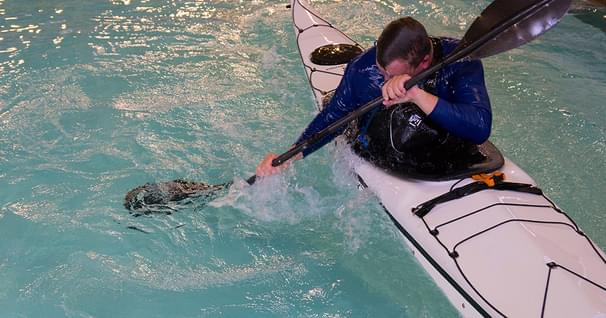Focused Skills
You begin by running rapids that require precise maneuvering. Then, you power across a huge lake into a determined head-wind. Later, you descend a twisting stream that is barely wider than your canoe. Finally, when camp is pitched and supper is done, you FreeStyle your canoe just for fun. The diversity of wilderness travel demands that paddlers marginally master many methods at the expense of being expert at just one. Those who think in strictly black and white can expect some difficulty on a wilderness river. Here are some examples:
- Burnside River, Canada-above the Arctic Circle:
Five out of six vote to portage a powerful rapid. The dissenter, a Minnesota flat-water canoe racer, condescendingly says, "Hey, we run rapids like this in covered race boats all the time back home." He just doesn't get it! - Cree River, Saskatchewan:
Ahead is a pushy rapid with large waves and a meter-high ledge on the outside bend. I direct my crew to backferry around the inside curve, where the water is manageable. I model the procedure and two canoes follow. The third, manned by whitewater experts, peels into the maelstrom and capsizes. When we fish them out they tell us they couldn't turn the heavy canoe quickly enough to avoid the drop (surprise!). They say that whitewater schools frown on backferries. - In 2001, friends and I canoed a remote part of the Adirondacks in our solo canoes. One man (I'll call him Sam) was an award-winning FreeStyle paddler. He could pivot on a penny while balancing a gunnel millimeters above the water. I figured he would be the star of our trip. We set out on a big lake with a heavy headwind. My friends and I "sit'n switched" every few strokes with bent-shaft paddles. Sam kneeled in the canoe and C-stroked with a straight paddle. Surprisingly, he was able to keep up with us even though he never switched sides or got off his knees. When camp came, Sam was so sore he could barely climb out of his canoe. He popped some "canoe candy" (Tylenol), ate quickly and went directly to bed. He continued to kneel/C-stroke and pop pills every day for the rest of the trip. Days later, we were pushed by a brisk following wind, which caused our canoes to surf. Everyone but Sam was whooping and hollering and loving it all. Sam was scared to death. Soon after, he capsized in a riffle and refused to canoe any more "rapids".
As you can see, finely focused skills, judgment or equipment can spell trouble on a wilderness river. It's better to be a well-rounded, mid-level paddler who knows his or her limits than a focused expert who doesn't. It takes years to develop the proper respect for a wild river. Here's how to speed the learning curve:
- Spend some time with professional canoe racers. You'll learn to cover distance fast and use your muscles wisely.
- Take a FreeStyle canoeing class. You'll develop better balance, precise paddle placement and blade orientation skills, and more efficient braces.
- Take a white-water canoeing class, but paddle your tripping canoe, not a maneuverable sport boat. Practice "back-ferries" until you can do them in any current.
- Use a longer (1-3 inches) paddle than you are accustomed. A longer lever arm provides greater power, better control and a more stable brace in aerated water. By comparison, I use a 54", 12-degree bent shaft for cruising and a 56" straight paddle for the rapids.
- Don't paddle only "bow" or "stern". A good whitewater paddler is at home in either end of a canoe.
- See Bill Mason's "Whitewater doubles"/Path of the Paddle video (VHS). Those who think that Mason's techniques are outdated haven't paddled a loaded tripping canoe in rapids!
- Study "Paddle Your Own Canoe", by Gary and Joannie McGuffin. It's the best canoeing technique book on the planet.
- Read my book, "Expedition Canoeing". It includes advice from more than 30 of North America's top wilderness canoeists.
- Upgrade all wilderness rapids one class-example, a Class III pitch back home is a Class IV in the bush.
- Maintain a humble rather than hot dog attitude. Most problems can be avoided or minimized if you just do that.
Related Articles
As the days get shorter and the weather gets colder, it becomes harder to get out and paddle and easier…
Mention “pool session” and the first image that pops into most kayakers minds is a class in how to roll.…
Paddling alone is a recipe for danger. Bring a buddy and stay safe on the water.



